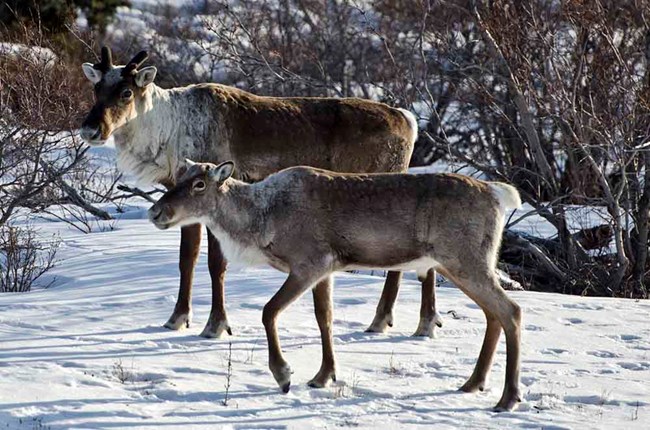Last updated: November 16, 2022
Article
Movement of Caribou and their Calves
Can you tell if a caribou has a calf without travelling out to the remote calving ground and looking? Researchers with the National Park Service, University of Alaska Fairbanks, and Alaska Department of Fish and Game (ADF&G) set out to answer this question. Using GPS collar data from 2010 to 2015 for the Western Arctic Herd in northwest Alaska, they used two different movement models to detect calving events specifically designed for woodland caribou, a relative of the migratory caribou in Alaska. These models test for a significant drop of the movement rate of the female caribou during calving, which indicates that she delivered a calf. Researchers compared these results from the GPS collar data to aerial observations taken each year by ADF&G personnel to determine how well the methods worked. They found that by using the two models together, they could be approximately 90% confident in the GPS-based result indicating a female caribou did or didn’t have a calf. This finding helps managers of caribou herds by providing a tool with which to identify if, when, and where a female has a calf in a given year.

NPS/Katie Thoreson
Movement-based methods to infer parturition events in migratory ungulates
Abstract
Long-distance migrations by ungulate species are a globally imperiled natural phenomenon and conservation of them requires monitoring population vital rates. Satellite telemetry tracking is widely used for understanding the spatial distribution and movement of animals, especially migratory animals in remote environments. Recently, analytical methods have been developed to infer parturition events from movement data in multiple species that calve in isolation, but to date such methods have not been tested on animals that both migrate and spatially aggregate during calving. We applied two movement-based methods developed to infer parturition in nonmigratory woodland caribou (Rangifer tarandus caribou (Gmelin, 1788) to 241 reproductive seasons spanning 6 years of GPS data from migratory barren-ground caribou (Rangifer tarandus granti J.A. Allen, 1902). We compared results from both methods to data from aerial surveys of collared females during the calving period. We found that each movement-based method had ∼80% overall accuracy to identify calving events, with interannual variation ranging from 61% to 100%. When we considered instances when the two analytical methods agreed on parturition outcome, the accuracy increased to 89% with an annual range of 73%–100%. Using these methods, we identified marked interannual differences in peak calving dates and higher parturition rates than previously reported for this caribou herd. The successful application of these analyses to a migratory, gregarious ungulate suggests a broader applicability of the methodology.
Cameron, M. D., K. Joly, G. A. Breed, L.S. Parrett, and K. Kielland. 2018. Movement-based methods to infer parturition events in migratory ungulates. Canadian Journal of Zoology 96:1187-1195. DOI: 10.1139/cjz-2017-0314.
